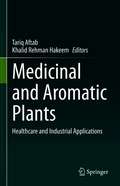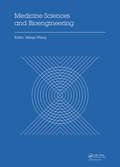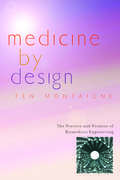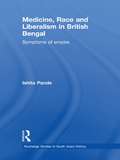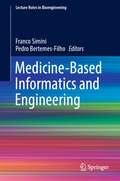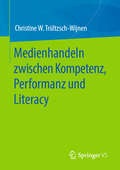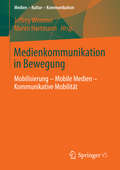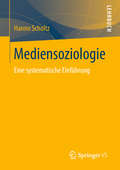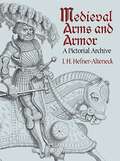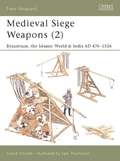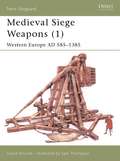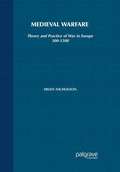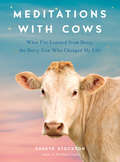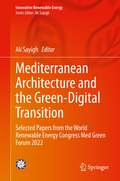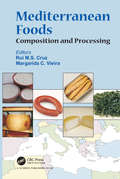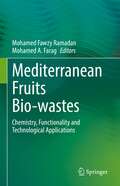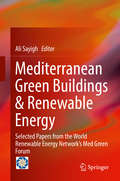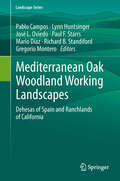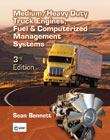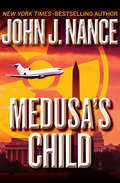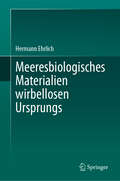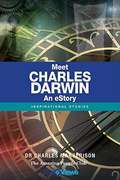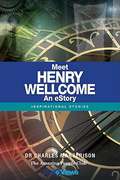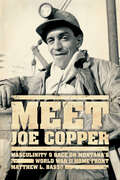- Table View
- List View
Medicinal and Aromatic Plants: Healthcare and Industrial Applications
by Khalid Rehman Hakeem Tariq AftabBefore the concept of history began, humans undoubtedly acquired life benefits by discovering medicinal and aromatic plants (MAPs) that were food and medicine. Today, a variety of available herbs and spices are used and enjoyed throughout the world and continue to promote good health. The international market is also quite welcoming for MAPs and essential oils. The increasing environment and nature conscious buyers encourage producers to produce high quality essential oils. These consumer choices lead to growing preference for organic and herbal based products in the world market. As the benefits of medicinal and aromatic plants are recognized, these plants will have a special role for humans in the future. Until last century, the production of botanicals relies to a large degree on wild-collection. However, the increasing commercial collection, largely unmonitored trade, and habitat loss lead to an incomparably growing pressure on plant populations in the wild. Therefore, medicinal and aromatic plants are of high priority for conservation. Given the above, we bring forth a comprehensive volume, “Medicinal and Aromatic Plants: Healthcare and Industrial Applications”, highlighting the various healthcare, industrial and pharmaceutical applications that are being used on these immensely important MAPs and its future prospects. This collection of chapters from the different areas dealing with MAPs caters to the need of all those who are working or have interest in the above topic.
Medicine Sciences and Bioengineering: Proceedings of the 2014 International Conference on Medicine Sciences and Bioengineering (ICMSB2014), Kunming, Yunnan, China, August 16-17, 2014
by Mings WangThis proceedings volume contains selected papers presented at the 2014 International Conference on Medicine Sciences and Bioengineering (ICMSB 2014), held August 16-17, 2014 in Kunming, Yunnan, China. ICMSB2014 was aimed at researchers, engineers, industrial professionals and academics, who were broadly welcomed to present their latest research res
Medicine by Design: The Practice and Promise of Biomedical Engineering
by Fen MontaigneA heart that once beat erratically has regained its natural rhythm. A woman paralyzed by an automobile accident is now able to resume her favorite hobby. Physicians using a robotic surgeon named da Vinci perform lifesaving operations. These are some of the feats of biomedical engineering, one of the fastest-moving areas in medicine. In this exhilarating book, award-winning writer Fen Montaigne journeys through this little-known world, sharing the stories of ordinary people who have been transformed by technology. From the almost commonplace pacemaker to the latest generation of artificial hearts, Montaigne tells the stories of pioneering patients, engineers, and surgeons. Taking the reader behind the scenes of a dozen of America's leading centers of biomedical engineering, Montaigne recounts the field's history while describing cutting-edge work in medical imaging, orthopedics, cardiovascular care, neurological therapies, and genetics. Through the stories of patients whose lives have been saved and improved by biomedical devices, Montaigne reveals the marriage of medicine and engineering to be one of society's greatest advances.
Medicine, Race and Liberalism in British Bengal: Symptoms of Empire (Routledge Studies in South Asian History)
by Ishita PandeThis book focuses on the entwinement of politics and medicine and power and knowledge in India during the age of empire. Using the powerful metaphor of ‘pathology’ - the science of the origin, nature, and course of diseases - the author develops and challenges a burgeoning literature on colonial medicine, moving beyond discussions of state medicine and the control of epidemics to everyday life, to show how medicine was a fundamental ideology of empire. Related to this point, and engaging with postcolonial histories of biopower and modernity, the book highlights the use of this racially grounded medicine in the formulation of modern selves and subjectivities in late colonial India. In tracing the cultural determinants of biological race theory and contextualizing the understanding of race as pathology, the book demonstrates how racialism was compatible with the ideologies and policies of imperial liberalism. Medicine, Race and Liberalism in British Bengal brings together the study of modern South Asia, race theory, colonialism and empire and the history of medicine. It highlights the powerful role played by the idea of ‘pathology’ in the rationalization of imperial liberalism and the subsequent projects of modernity embraced by native experts in Bengal in the ‘long’ nineteenth century.
Medicine-Based Informatics and Engineering (Lecture Notes in Bioengineering)
by Franco Simini Pedro Bertemes-FilhoThis book originates from the idea to adapt biomedical engineering and medical informatics to current clinical needs and proposes a paradigm shift in medical engineering, where the limitations of technology should no longer be the starting point of design, but rather the development of biomedical devices, software, and systems should stem from clinical needs and wishes. Gathering chapters written by authoritative researchers, working the interface between medicine and engineering, this book presents successful attempts of conceiving technology based on clinical practice. It reports on new strategies for medical diagnosis, rehabilitation, and eHealth, focusing on solutions to foster better quality of life through technology, with an emphasis on patients’ and clinical needs, and vulnerable populations. All in all, the book offers a reference guide and a source of inspiration for biomedical engineers, clinical scientists, physicians, and computer scientists. Yet, it also includes practical information for personnel using biomedical equipment, as well as timely insights that are expected to help health agencies and software firms in their decision-making processes.
Medienhandeln zwischen Kompetenz, Performanz und Literacy
by Christine W. Trültzsch-WijnenDas Buch diskutiert die soziale und individuelle Bedingtheit von Medienkompetenz. Im Mittelpunkt steht die Frage, wie sich das Medienhandeln von Individuen im Hinblick auf deren Medienkompetenz, im Sinne eines sicheren und selbstbestimmten Handelns im Umgang mit Medien, erklären und beurteilen lässt. Dies setzt eine Betrachtung des Medienhandelns vor dem Hintergrund der Beziehungen zwischen der Kompetenz zu Handeln, als Summe von Fähigkeiten, Fertigkeiten und Wissen sowie der kognitiven Beherrschung von Regeln des Verhaltens (moralische Regeln, rechtliche Regeln sowie Regeln der Klugheit), und der Performanz, als tatsächliches Handeln eines Individuums, voraus. Dabei wird auf theoretischer Ebene der Frage nach der sozialen Determinierung eines selbstbestimmten Handelns im Umgang mit Medien einschließlich dafür erforderlicher Fähigkeiten, Fertigkeiten sowie des damit verbundenen Wissens nachgegangen. Außerdem wird das Verhältnis des deutschsprachigen Medienkompetenzdiskurses zum internationalen Diskurs über media literacy erläutert. Es werden Gemeinsamkeiten und Unterschiede herausgearbeitet und Potentiale für eine gegenseitige Befruchtung beider Perspektiven aufgezeigt. Darüber hinaus wird die empirische Relevanz und Anwendbarkeit dieser theoretischen Überlegungen anhand zweier Studien illustriert.
Medienkommunikation in Bewegung
by Jeffrey Wimmer Maren HartmannIn heutigen Gesellschaften stehen soziale, informationelle und räumliche Mobilität und digitale Kommunikationsmedien in einem engen Zusammenhang. Medien werden dabei nicht nur immer mobiler, sondern die Menschen verwenden sie auch zunehmend zum Zwecke kommunikativer Mobilität. Die vielfältigen Dimensionen individueller wie gesellschaftlicher Mobilitäts- und Mobilisierungsprozesse werden aus einer kommunikations- und mediensoziologischen Perspektive sowohl theoretisch als auch empirisch verortet. Dabei werden die Erträge bisheriger Forschungsansätze kritisch reflektiert und ein Blick auf zukünftige Forschungsherausforderungen geworfen und damit neue Impulse für die Diskussion geliefert.
Mediensoziologie: Eine systematische Einführung
by Hanno ScholtzWas haben Veränderungen in Gesellschaften und ihren Medien miteinander zu tun? Wo tragen Medien zu gesellschaftlichen Problemen bei und wo können sie diese lösen helfen? Wie wird darüber in der Wissenschaft diskutiert, und wie hängen diese Diskussionen zusammen? Ausgehend von Individuen mit ihren Wahrnehmungen und Handlungsentscheidungen, den von ihnen begründeten Institutionen, und einer knappen Definition von Medien bietet dieser Einführungsband in die Mediensoziologie eine systematische Darstellung, die einen Überblick ermöglicht und Probleme und im Fach geführte Diskussionen einordnen lässt.
Medieval Arms and Armor: A Pictorial Archive
by J. H. Hefner-AlteneckA renowned 19th-century cultural historian and specialist on the Middle Ages, J. H. Hefner-Alteneck spent much of his life observing the influence of art on many aspects of human life, including weaponry. His illustrations for this handsome archive — drawn with incredible exactitude — depict a wide array of medieval weapons and armor dating from the early ninth century to the mid-1700s.Adapted primarily from decorative ornamentation on burial monuments and manuscripts, hundreds of finely executed images depict authentic shields, swords, crossbows, helmets, and highly ornate suits of body armor for knights and their steeds. Newly translated descriptive notes, extracted from the original German text, identify the subjects. First published more than 100 years ago, this meticulously rendered study remains an invaluable source of permission-free illustrations for artists and designers and an indispensable reference for scholars, collectors, and hobbyists.
Medieval Siege Weapons: Byzantium, the Islamic World & India AD 476-1526
by David NicolleDuring medieval era, the pre-existing military-technological traditions from the ancient worlds were brought together. Three civilizations were primarily responsible for this evolution: the Late-Roman or Byzantine Empire, the Islamic World, and latterly the Mongol 'World Empire'. This book examines the resulting stone-throwing machines from torsion 'energy storage' systems, to manpowered and counterbalance sling devices, rockets and others.
Medieval Siege Weapons: Western Europe AD 585-1385
by David NicolleThis text explores a range of devices and details the changes in medieval siege warfare brought about by the mixing of traditions from Greece, Rome, Persia, India and China.
Medieval Warfare: Theory and Practice of War in Europe 300–1500
by Helen NicholsonWarfare in medieval times was never static or predictable - although there were ideals and conventions to follow, in the field commanders had to use their initiative and adapt to the needs of the moment. In this concise, wide-ranging study, Helen Nicholson provides the essential introductory guide to a fascinating subject. Medieval Warfare - surveys and summarises current debates and modern research into warfare throughout the whole of the medieval period across Europe - sets medieval warfare theory and practice firmly into context as a continuation and adaptation of practice under the Roman Empire, tracing its change and development across more than a millennium - considers military personnel, buildings and equipment, as well as the practice of warfare by land and sea
Meditations with Cows: What I've Learned from Daisy, the Dairy Cow Who Changed My Life
by Shreve StocktonAn intimate memoir on the work and wonder of ranch life, critiquing the inhumane and environmentally destructive factory farm system and offering sustainable alternatives for ethical omnivores.Although there are nearly 100 million cattle in the United States, these animals are often ignored or dismissed. In Meditations with Cows, Shreve Stockton inspires a more reverential attitude toward these affectionate and intelligent creatures as she shares captivating stories and photos of ranch life. At the center of the narrative is Daisy, the matriarch of the herd. Through the daily ritual of milking, Stockton forges a relationship with Daisy that deepens with each passing season: "When you have a milk cow, you are together every day, no matter the weather, no matter either of your moods. The hind leg of this twelve-hundred-pound animal towers over you as you crouch beside her... both of you aware of the fact that one well-aimed kick could kill you if she wished. Yet you are allowed to rest your cheek and forehead against her warm belly as you milk... her trust in you entwined with your trust in her, you become family." For anyone who loves animals or cares about the environmental impact of their food, Stockton explores conservation and the important role of cattle in local ecosystems, models the humane treatment of animals, and shows how pastured cattle can be our allies in averting climate crisis. Blending together narrative, science, and thoughtful reflection, Meditations with Cows offers a moving portrait of the rhythms of work, life, and hardship on the ranch.
Mediterranean Architecture and the Green-Digital Transition: Selected Papers from the World Renewable Energy Congress Med Green Forum 2022 (Innovative Renewable Energy)
by Ali SayighThis book contains selected papers presented during the World Renewable Energy Network’s biannual World Med Green Forum (MGF). The 2022 MGF highlights the role of renewable energy applications in the sustainable building sector with a focus on the Mediterranean region as a foundation for a truly positive energy future. MGF is an open roundtable for an international community of researchers, practitioners, and experts to discuss the most innovative and promising sustainable building technologies. The papers presented explore the intersection between twin transitions in policies, programs, projects, and experimentation, with the digital domain innovating the green building sector towards more reliable and inclusive planning and design practices in order to collectively envision future buildings and cities.
Mediterranean Foods: Composition and Processing
by Rui M. da Cruz Maria M. VieiraThe Mediterranean region is well known around the world for its rich culinary history. While most books tend to only focus on the nutritional, culinary, and/or health aspects of Mediterranean cuisine, this book presents a more scientific approach and discusses the composition of specific foods from the Mediterranean basin as well as specific processing methodologies applied to produce food in this area of the world.
Mediterranean Fruits Bio-wastes: Chemistry, Functionality and Technological Applications
by Mohamed Fawzy Ramadan Mohamed A. FaragTraditional Mediterranean fruits (i.e., be grapes, oranges, apples, pears, peaches, cherries, plums, figs, melons, watermelon and dates) are of major commercial and nutritional value to the region. Processing of such fruits, however, results in large amounts of bio-waste material. Efficient, inexpensive and environmentally friendly use of fruit industry waste is thus highly cost-effective and minimizes environmental impact. The natural antioxidants and bioactive compounds found in Mediterranean fruit bio-wastes could play a major role in the alleged health benefits of the Mediterranean diet, and could be used in pharmaceuticals as well as novel food applications. This book presents a multidisciplinary forum of discussion on the chemistry, functional properties and health-promoting effects of bioactive compounds in Mediterranean fruit bio-wastes, as well as novel food and non-food applications. The text provides the scientific fundamentals of the health-promoting benefits and applications of Mediterranean fruit bio-wastes, reviews the relevant recovery issues and explores different techniques to develop new applications. With a diversity of perspectives, from food science to environmental chemistry and horticultural research, this volume provides comprehensive, up-to-date knowledge to researchers and industry professionals working in the areas of food waste valorization.
Mediterranean Green Buildings & Renewable Energy: Selected Papers from the World Renewable Energy Network's Med Green Forum
by Ali SayighThis book highlights scientific achievements in the key areas of sustainable electricity generation and green building technologies, as presented in the vital bi-annual World Renewable Energy Network’s Med Green Forum. Renewable energy applications in power generation and sustainable development have particular importance in the Mediterranean region, with its rich natural resources and conducive climate, making it a perfect showcase to illustrate the viability of using renewable energy to satisfy all energy needs. The papers included in this work describe enabling policies and offer pathways to further develop a broad range of renewable energy technologies and applications in all sectors – for electricity production, heating and cooling, agricultural applications, water desalination, industrial applications and for the transport sector.
Mediterranean Oak Woodland Working Landscapes
by Gregorio Montero Jose Luis Oviedo Pro Lynn Huntsinger Mario Diaz Pablo Campos Paul F Starrs Richard B StandifordThe oak tree was a boon companion as humans expanded their presence across much of the globe. While oak woodlands (Quercus spp.) come today in stunningly diverse forms, the stately dehesas of Spain and the dramatic oak-dominated ranchlands of California are working landscapes where cultivation and manipulation for a couple of millennia have shaped Mediterranean-type ecosystems into a profoundly modified yet productive environment that is sought-after by every manner of species. The grazing of wildlife and livestock in oak woodlands yields a remarkable plant and animal biodiversity, creating a mosaic of habitats and visually pleasing savannas. Added products unique to Spain such as Iberian pigs and cork, and in California multiple landowner benefits, include valued ecosystem services that allow owners, visitors, and conservation supporters to experience the benefits of woodland life. With its 15 chapters a decade in the making, this handsomely illustrated book covers key topics in oak woodland policy, ecology, and management in Spain and California, presenting new research results and reviewing an existing expert literature.
Mediterranean Protected Areas in the Era of Overtourism: Challenges and Solutions
by Ante Mandić Lidija PetrićThis book comprises studies that reflect on various influences of excessive tourism development in protected areas, and solutions designed and initiated to mitigate such challenges. A large proportion of tourism in Mediterranean destinations constitutes nature-based tourism, in particular, tourism in parks and protected areas. As a destination experiences higher intensity and density of tourism, the potential conflict between maintaining a healthy natural environment and economic development also increases. This has urged planners and decision-makers to devise and adopt innovative approaches that seek to strike a balance between tourism development and nature conservation. This book demonstrates the importance of collaboration across and beyond disciplines and of all groups of stakeholders for maximization of societal impacts and tourism-related benefits.
Medium/Heavy Duty Truck Engines, Fuel And Computerized Management Systems
by Sean BennettThe most comprehensive guide to highway diesel engines and their management systems available today, Medium/Heavy Duty Truck Engines, Fuel & Computerized Management Systems, 3E is a user-friendly resource for both entry-level and experienced technicians alike. Coverage includes the full range of truck diesels, from light duty to heavy duty, as well as the most current diesel engine management electronics used in the industry. The updated third edition features all-new discussions of series and parallel hybrid drive trains that use both electric and hydraulic hybrid technology, emerging battery and ultra capacitor technology popular in hybrid electric vehicles, expanded coverage of the new Delphi E3 injectors used in post-2007 Caterpillar, Detroit Diesel, Volvo and Mack engines, and more. With an emphasis on today's computer technology that sets it apart from any other book on the market, this is an ideal guide to working effectively in modern truck service facilities.
Medusa's Child
by John J. NanceA pilot races through the sky to stop a nuclear catastrophe in this &“compelling&” thriller by the New York Times–bestselling author of Pandora&’s Clock (People). Vivian Henry hasn&’t heard her ex-husband&’s voice in three years, but it still fills her with fear. Dangerous and brilliant, Dr. Rogers Henry is calling because he&’s dying. He offers Vivian a fortune in insurance money if she&’ll carry out one final task for him: Take the Medusa device to Washington, DC. The Medusa is his life&’s work—a thermonuclear bomb capable of knocking out all modern technology in the country—and he wants her to deliver it to the Pentagon before it falls into the wrong hands. Cargo plane captain Scott McKay is miles above the ground when the Medusa begins to speak. A recording of Dr. Henry&’s voice announces that the device is active and about to explode. With nowhere to land, Captain McKay must rely on his instincts and fly like he has never flown before to prevent a worldwide apocalypse. Medusa&’s Child proves once again that John Nance is the &“king of the modern-day aviation thriller&” (Publishers Weekly).
Meeresbiologisches Materialien wirbellosen Ursprungs
by Hermann EhrlichDas Buch Das Werk ist eine Quelle für modernes Wissen über Biomineralisation, Biomimetik und bioinspirierte Materialwissenschaft in Bezug auf wirbellose Meerestiere. Der Autor liefert die kohärenteste Analyse der Natur, des Ursprungs und der Entwicklung von Biokompositen und Biopolymeren, die aus der großen Vielfalt der wirbellosen Meeresorganismen isoliert und in deren ungewöhnlichen Strukturformationen beobachtet wurden. Das grundlegende Format ist das eines großen Übersichtsartikels, mit großzügiger Verwendung von Verweisen auf die Originalliteratur. Das Buch enthält eine Fülle neuer und neu zusammengestellter Informationen, darunter Dutzende von bisher unveröffentlichten Bildern einzigartiger mariner Lebewesen und Strukturen vom Nano- bis zum Mikrobereich, einschließlich hochauflösender Raster- und Transmissionselektronenmikroskopaufnahmen. Das Material ist sowohl nach biologischen (Phyla) als auch nach funktionellen Gesichtspunkten geordnet. Es wird eine Klassifizierung der biologischen Materialien marinen Ursprungs vorgeschlagen und diskutiert. Ein Großteil der einschlägigen Daten ist in Tabellen organisiert, und es wird ausgiebig Gebrauch von elektronenmikroskopischen Aufnahmen und Strichzeichnungen gemacht. Mehrere moderne Themen, wie z.B. "Biomineralisierungs-, Demineralisierungs- und Remineralisierungsphänomene" oder "Phänomene der mehrphasigen Biomineralisation", werden ausführlich diskutiert. Traditionell werden aktuelle Konzepte wie die hierarchische Organisation von Biokompositen und Skelettstrukturen, strukturelle Biogerüste, Bioskulpturierung, Biomimetismus und Bioinspiration als Werkzeuge für das Design innovativer Materialien sowohl aus biologischer als auch aus materialwissenschaftlicher Sicht anhand zahlreicher einzigartiger Beispiele marinen Ursprungs kritisch analysiert. Diese Monographie gibt einen Überblick über die wichtigsten Fortschritte auf dem Gebiet der marinen Biomaterialien und zeigt mehrere Ansätze auf, die von verschiedenen Labors eingeführt und erforscht werden."
Meet Charles Darwin - An eStory
by Charles MargerisonMeet Charles Darwin, responsible for the theory of natural selection and author of On Origin of the Species. Darwin is arguably one of the most influential characters in world history, in that he redefined so many pre-conceived ideas. He was far ahead of his time. His amazing life comes alive through BioViews. You can follow the young Darwin from his early years, when his mother died, to his medical studies where his curiosity in natural order and development sent him off on explorations that would ultimately change the way the world is regarded.A BioView® is a short biographical story, similar to an interview. These unique audio stories provide an easy way of learning about amazing people who made major contributions to our world.
Meet Henry Wellcome - An eStory
by Charles MargerisonMeet Henry Wellcome. Discover his amazing life story in this unique audio story from The Amazing People Club. He may have saved your life with the medicines he developed and produced. Henry willed his entire fortune to further development and research to The Wellcome Trust, which is one of the largest biomedical charities in the world. Travel with Henry Wellcome from the log cabin in which he was born in Wisconsin on his epic journeys around the world, driven by his thirst for knowledge and insatiable curiosity. Henry Wellcome's story comes to life through BioViews®. These are short biographical narratives, similar to interviews. They provide an easy way of learning about amazing people who made major contributions and changed our world.
Meet Joe Copper: Masculinity and Race on Montana's World War II Home Front
by Matthew L. BassoOC I realize that I am a soldier of production whose duties are as important in this war as those of the man behind the gun. OCO So began the pledge that many home front men took at the outset of World War II when they went to work in the factories, fields, and mines while their compatriots fought in the battlefields of Europe and on the bloody beaches of the Pacific. The male experience of working and living in wartime America is rarely examined, but the story of men like these provides a crucial counter-narrative to the national story of Rosie the Riveter and GI Joe that dominates scholarly and popular discussions of World War II. In "Meet Joe Copper," Matthew L. Basso describes the formation of a powerful, white, working-class masculine ideology in the decades prior to the war, and shows how it thrivedOCoon the job, in the community, and through union politics. Basso recalls for us the practices and beliefs of the first- and second-generation immigrant copper workers of Montana while advancing the historical conversation on gender, class, and the formation of a white ethnic racial identity. "Meet Joe Copper" provides a context for our ideas of postwar masculinity and whiteness and finally returns the men of the home front to our reckoning of the Greatest Generation and the New Deal era.
